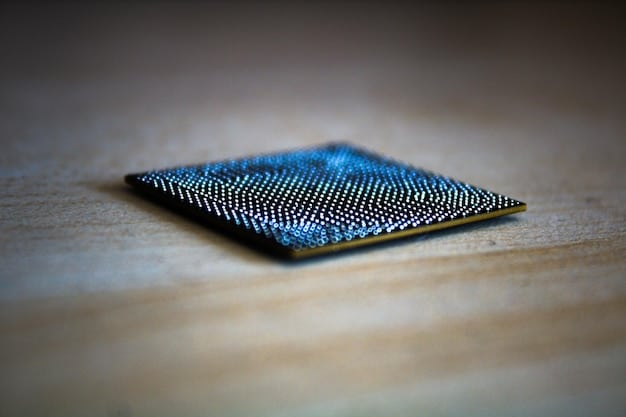US AI Research: CHIPS Act Impact on Semiconductor Innovation by 2025

The CHIPS and Science Act, enacted in the US, aims to bolster semiconductor innovation through significant funding and strategic initiatives; its impact on US AI research and semiconductor advancements is projected to be substantial by 2025, fostering growth and competitiveness.
The landscape of US AI Research: Analyzing the Impact of the CHIPS and Science Act on Semiconductor Innovation by 2025 is poised for significant transformation. This analysis delves into how the CHIPS Act could revolutionize semiconductor technology and AI research within the United States.
Analyzing the CHIPS and Science Act: A Detailed Overview
The CHIPS and Science Act represents a pivotal moment for the United States, particularly in its ambition to revitalize the domestic semiconductor industry and fortify its position in AI research. Understanding its key components is crucial to grasping its potential impact.
Key Provisions of the CHIPS Act
The CHIPS Act, signed into law, allocates billions of dollars to strengthen US semiconductor manufacturing, research, and development. This aims to reduce reliance on foreign sources and boost domestic technological capabilities.
Science Act’s Role in AI Advancement
Complementing the CHIPS Act, the Science Act provides funding for fundamental research in science and technology, including artificial intelligence. This aims to foster innovation and maintain US leadership in these critical fields.
- Funding for semiconductor manufacturing incentives and research.
- Tax credits for investments in semiconductor manufacturing equipment.
- Support for research and development in areas like AI, quantum computing, and advanced manufacturing.
- Establishment of regional technology hubs to promote innovation and job creation.
In summary, The CHIPS and Science Act are designed to bolster the US semiconductor industry and foster AI research by providing essential funding, incentives, and support for innovation.

Projected Growth in Semiconductor Manufacturing
One of the primary goals of the CHIPS Act is to stimulate growth in US semiconductor manufacturing. This involves not only increasing production capacity but also advancing the technological capabilities of domestic manufacturers.
Impact on Domestic Production Capacity
The funding and incentives provided by the CHIPS Act are expected to lead to significant increases in domestic semiconductor production capacity, reducing dependence on foreign suppliers.
Technological Advancements in Manufacturing Techniques
Investments in research and development will drive advancements in manufacturing techniques, allowing US companies to produce more advanced and efficient semiconductors. This is crucial for maintaining competitiveness in the global market.
- Increased investment in new semiconductor fabrication plants (fabs) across the US.
- Adoption of advanced manufacturing processes such as extreme ultraviolet (EUV) lithography.
- Development of novel materials and designs for more efficient and powerful semiconductors.
- Creation of high-skilled jobs in semiconductor manufacturing and related industries.
In conclusion, the anticipated growth in semiconductor manufacturing, spurred by the CHIPS Act, will strengthen domestic production capacity, foster technological advancements, and create high-skilled jobs.
Advancements in AI Research and Development
The Science Act component of the CHIPS and Science Act plays a crucial role in driving advancements in AI research and development. This involves supporting fundamental research, promoting collaboration, and fostering innovation in various AI subfields.
Funding for AI Research Initiatives
The Science Act allocates substantial funding for AI research initiatives, including grants for universities, research institutions, and private companies. This funding supports a wide range of AI projects, from basic research to applied development.
Collaboration Between Academia and Industry
The act promotes collaboration between academia and industry, fostering partnerships that accelerate the translation of research findings into practical applications. This ensures that AI research remains relevant and responsive to real-world needs.

- Increased funding for AI research grants and fellowships.
- Establishment of new AI research centers and institutes.
- Support for interdisciplinary research projects that combine AI with other fields like robotics, healthcare, and energy.
- Development of ethical guidelines and standards for AI development and deployment.
Ultimately, advancements in AI research and development, facilitated by the Science Act, will lead to breakthroughs in various AI subfields, promote collaboration, and ensure ethical AI development and deployment.
Impact on Key Industries: Healthcare, Automotive, and Energy
The advancements in semiconductor technology and AI research, driven by the CHIPS and Science Act, are expected to have a transformative impact on key industries such as healthcare, automotive, and energy. These industries rely heavily on semiconductors and AI for innovation and efficiency.
Healthcare
In healthcare, AI-powered diagnostics, personalized medicine, and robotic surgery are becoming increasingly prevalent. Advanced semiconductors enable more powerful and efficient medical devices, improving patient outcomes and reducing costs.
Automotive
The automotive industry is undergoing a revolution with the advent of autonomous vehicles and advanced driver-assistance systems (ADAS). Semiconductors and AI are at the heart of these technologies, enabling vehicles to perceive their surroundings, make decisions, and navigate safely.
- Improved diagnostics and personalized medicine through AI-driven analysis of patient data.
- Enhanced efficiency and safety in autonomous vehicles and advanced driver-assistance systems.
- Smarter and more sustainable energy grids through AI-optimized resource management.
- Increased automation and efficiency in manufacturing processes across all sectors.
Energy
The energy sector is also benefiting from advancements in semiconductors and AI. Smart grids, powered by AI, can optimize energy distribution, reduce waste, and integrate renewable energy sources more efficiently. Advanced sensors and control systems, enabled by semiconductors, improve the reliability and performance of energy infrastructure.
In summary, the impact on key industries, driven by these advancements, will lead to improved diagnostics, enhanced efficiency and safety, smarter energy grids, and increased automation across sectors.
Challenges and Potential Roadblocks
While the CHIPS and Science Act holds immense promise, its successful implementation faces several challenges and potential roadblocks. Addressing these challenges is crucial to realizing the act’s full potential and ensuring its long-term impact.
Workforce Development and Talent Acquisition
One of the most significant challenges is the need for a skilled workforce to support the growing semiconductor industry and AI research ecosystem. Attracting, training, and retaining talent is essential for sustaining innovation and competitiveness.
Geopolitical Uncertainties and Supply Chain Disruptions
Geopolitical uncertainties and potential supply chain disruptions could also hinder the act’s implementation. Ensuring access to critical materials, equipment, and expertise is vital for maintaining a stable and resilient semiconductor industry.
- Addressing the shortage of skilled workers in semiconductor manufacturing and AI research.
- Mitigating potential disruptions to the supply chain of critical materials and equipment.
- Ensuring that the benefits of the act are distributed equitably across different regions and communities.
- Adapting to evolving geopolitical dynamics and maintaining a competitive edge.
To conclude, overcoming these challenges is essential for maximizing the benefits of the CHIPS and Science Act and ensuring its long-term success.
Looking Ahead: The Future of US AI and Semiconductor Innovation
As we look ahead to 2025 and beyond, the future of US AI and semiconductor innovation is bright, thanks in part to the CHIPS and Science Act. However, sustained investment, strategic planning, and effective implementation are essential to maintaining momentum and achieving long-term success.
Continued Investment in R&D
Continued investment in research and development is crucial for driving innovation and staying ahead of global competition. This includes funding for basic research, applied development, and technology transfer initiatives.
Strategic Partnerships and International Collaboration
Strategic partnerships and international collaboration can also play a key role in fostering innovation and expanding market opportunities. Collaborating with allies and partners on research projects, standards development, and supply chain security can strengthen the US position in the global technology landscape.
- Sustaining investment in research, development, and workforce training.
- Fostering collaboration between government, industry, and academia.
- Adapting to emerging trends and disruptive technologies.
- Promoting ethical and responsible innovation that benefits society as a whole.
In summary, the future of US AI and semiconductor innovation relies on sustained investment, strategic partnerships, and a commitment to ethical and responsible innovation.
| Key Aspect | Brief Description |
|---|---|
| 💰 Funding Boost | Billions allocated to enhance US semiconductor manufacturing and research. |
| 📈 Production Growth | Expected increase in domestic semiconductor production capacity. |
| 🤖 AI Advancement | Support for AI research initiatives and collaboration between academia and industry. |
| 🌍 Industry Impact | Transformative effects on healthcare, automotive and energy sectors. |
Frequently Asked Questions
▼
The CHIPS and Science Act is a US law providing billions in funding to boost domestic semiconductor manufacturing, AI research, and development, aiming to strengthen US competitiveness and reduce reliance on foreign suppliers.
▼
By 2025, the Act is expected to accelerate AI research through increased funding, fostering innovation and collaboration between academia and industry, leading to significant technological advancements.
▼
Key industries such as healthcare, automotive, and energy stand to gain significantly, with AI and semiconductor advancements driving innovations in diagnostics, autonomous systems, and sustainable energy solutions.
▼
Challenges include addressing workforce shortages, mitigating supply chain disruptions, and ensuring equitable distribution of benefits across different regions and communities to maximize the Act’s impact.
▼
The Act encourages strategic partnerships and international collaboration to boost innovation, expand market opportunities, and strengthen the US position in the global technology landscape through joint research and standards development.
Conclusion
In conclusion, the CHIPS and Science Act signifies a major stride toward fortifying US leadership in AI and semiconductor technology. Its success hinges on overcoming key challenges and sustaining investment to ensure a vibrant future for American innovation.





